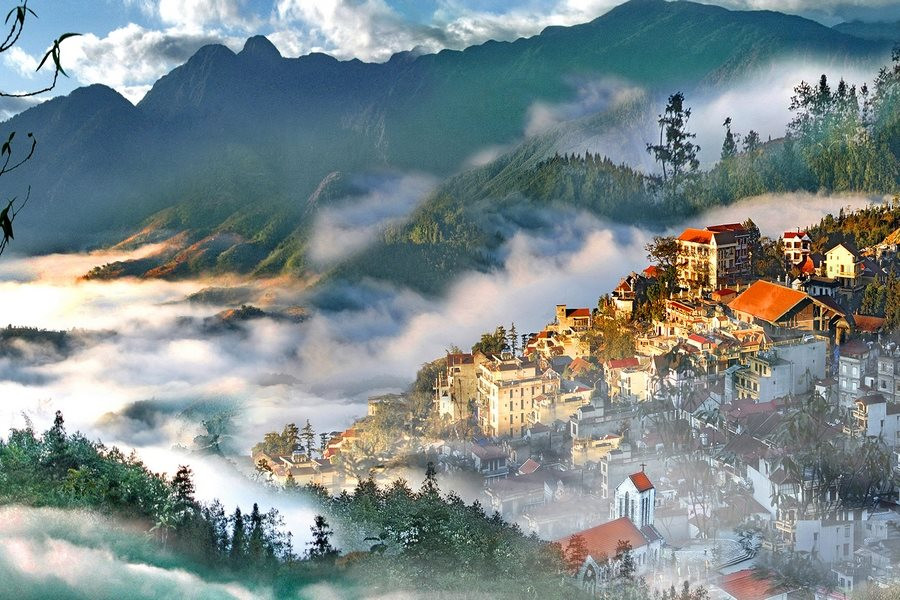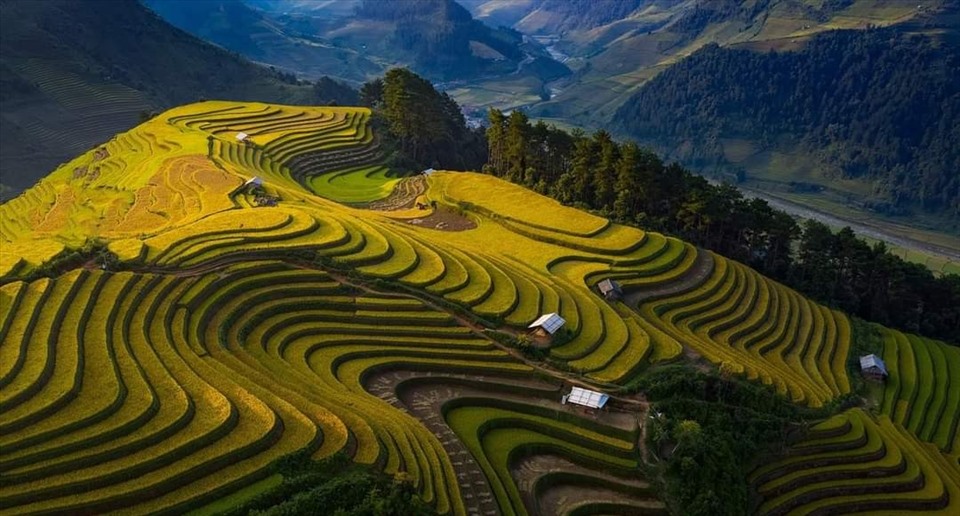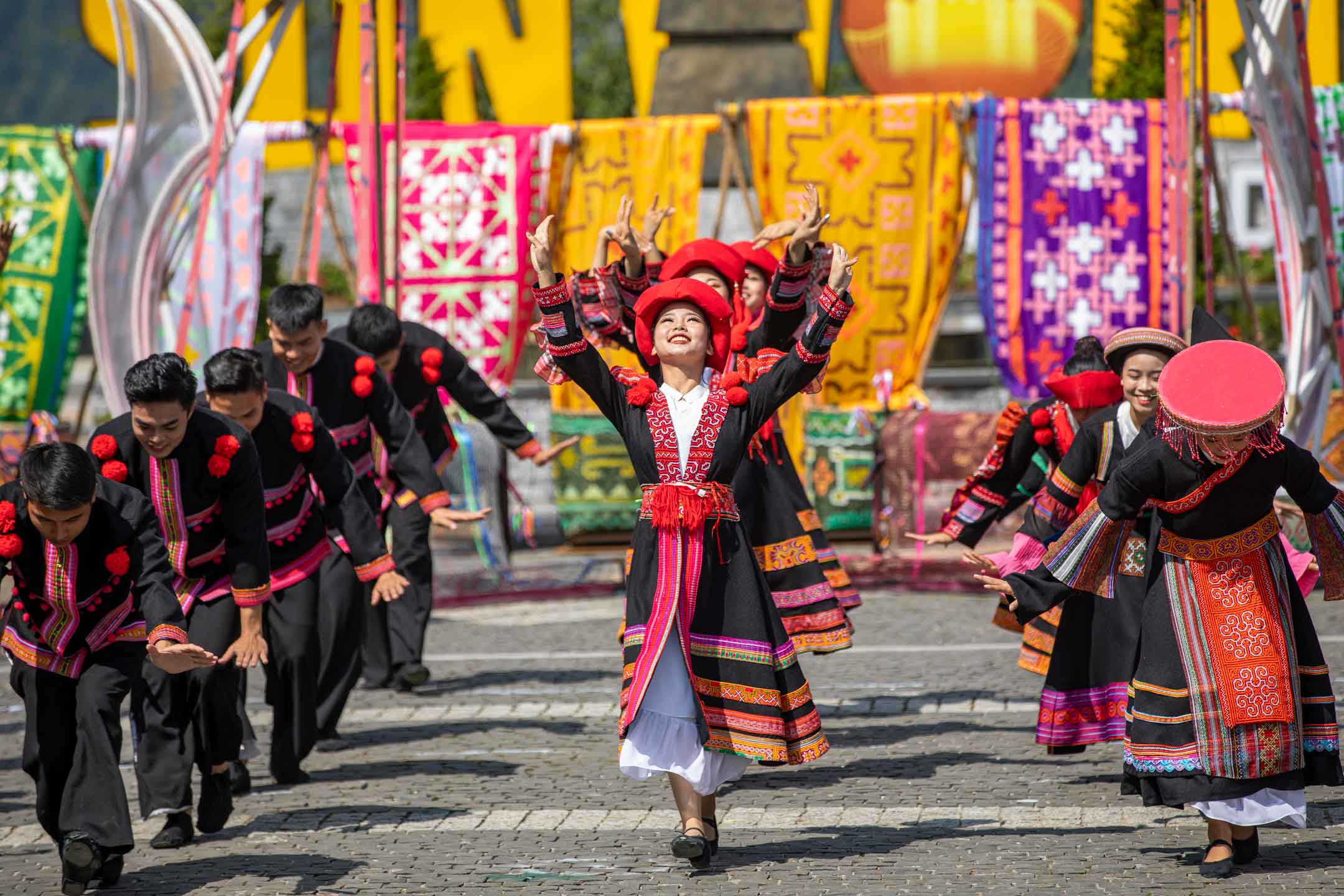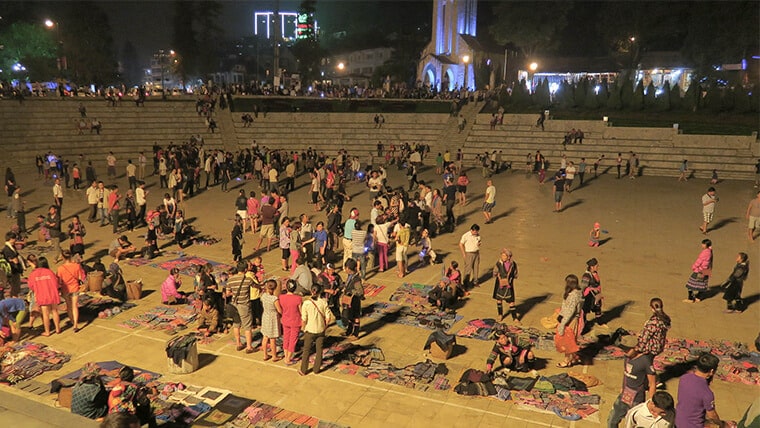Geographical Location and Accessibility
Sapa is situated approximately 315 kilometers northwest of Hanoi, nestled in the Hoang Lien Son mountain range near the Chinese border. It’s accessible by various means of transportation, with the most popular being the overnight train or bus from Hanoi to Lao Cai Province, followed by a short bus or taxi ride to Sapa. The journey typically takes about 8-9 hours. If you’re deciding between Sapa or Mu Cang Chai, Sapa offers slightly easier access for travelers. Mu Cang Chai is located around 300 kilometers northwest of Hanoi, in a more remote area compared to Sapa. It’s best accessed by road, either by bus or car, with the journey taking about 7-8 hours. While the travel time is similar, Mu Cang Chai’s remoteness means fewer tourists, making it an ideal destination for those seeking tranquility and an authentic experience.
Mu Cang Chai is located around 300 kilometers northwest of Hanoi, in a more remote area compared to Sapa. It’s best accessed by road, either by bus or car, with the journey taking about 7-8 hours. While the travel time is similar, Mu Cang Chai’s remoteness means fewer tourists, making it an ideal destination for those seeking tranquility and an authentic experience.
Natural Beauty: Sapa or Mu Cang Chai
- Sapa: When comparing Sapa or Mu Cang Chai, Sapa’s natural beauty is defined by its dramatic mountainous landscapes, lush valleys, and expansive terraced fields. The town itself is perched on the edge of a deep valley, offering stunning views of the surrounding peaks, including the famous Fansipan, the highest mountain in Vietnam. The terraced rice fields in Sapa are a sight to behold, particularly during the harvest season when they turn golden. The area is also rich in biodiversity, with the Hoang Lien National Park providing a haven for rare flora and fauna. Waterfalls, bamboo forests, and hidden caves add to the natural allure of Sapa, making it a paradise for nature lovers and adventure seekers alike. For those drawn to nature, Sapa or Mu Cang Chai will both captivate, but Sapa offers a more developed tourist infrastructure.
- Mu Cang Chai: This place is celebrated for its magnificent terraced rice fields, which are considered some of the most beautiful in the world. These terraces, created by the local Hmong people, are not only a testament to human ingenuity but also a breathtaking natural wonder. The terraces stretch across the mountains, following the contours of the land and creating a visual masterpiece that changes with the seasons. During the planting season, the fields are a vibrant green, while the harvest season sees them turn a rich golden hue. The landscape is further enhanced by the mist that often envelops the mountains in the early morning, adding a mystical quality to the scenery. For those deciding between Sapa or Mu Cang Chai, Mu Cang Chai’s raw and untouched beauty is unparalleled.
Cultural Experiences
Sapa
Sapa is home to several ethnic minority groups, including the Hmong, Dao, Tay, and Giay. Exploring their traditions is one of the main reasons to choose Sapa or Mu Cang Chai. These communities have preserved their traditional ways of life, making Sapa a cultural treasure trove. Visitors to Sapa can explore local villages, such as Cat Cat, Ta Phin, and Lao Chai, where they can observe traditional crafts, farming techniques, and daily activities.The vibrant markets in Sapa, particularly the Bac Ha Market, are another highlight, where locals gather to trade goods, socialize, and wear their traditional costumes. Participating in a homestay with a local family is a popular way to immerse yourself in the culture, offering an authentic experience of the local lifestyle, customs, and cuisine.
Mu Cang Chai
Mu Cang Chai, though less visited than Sapa, offers equally rich cultural experiences. The region is predominantly inhabited by the Hmong people, who have lived in harmony with the land for generations. The Hmong culture is evident in the traditional clothing, music, and festivals that you can experience in the villages.Visitors to Mu Cang Chai can take part in daily activities such as farming, handicraft making, and cooking with local families. The slow pace of life in Mu Cang Chai allows for deeper interactions with the locals, providing insight into their traditions and way of life, making Sapa or Mu Cang Chai a difficult choice for those seeking authentic connections. However, the region’s remoteness also means that cultural experiences here are often more intimate and less commercialized than in Sapa.Trekking Adventure: Sapa or Mu Cang Chai
Sapa
Sapa or Mu Cang Chai’s trekking will both impress. For Sapa, this location is renowned for its trekking opportunities, offering a variety of trails that cater to different skill levels. From short walks through the rice fields to multi-day treks up Fansipan, Sapa has something for everyone. Sapa treks take you through lush valleys, terraced fields, and ethnic minority villages, providing stunning views and cultural encounters along the way.
Read more: Sapa Hikes: Must-Do Trekking Routes
The most popular trek is the hike to Fansipan, known as the “Roof of Indochina”. This challenging trek takes 2-3 days, with the reward of breathtaking panoramic views from the summit. For adventurers considering Sapa or Mu Cang Chai, treks through the Muong Hoa Valley offer beautiful scenery and the chance to visit several traditional villages.Mu Cang Chai
Trekking in Mu Cang Chai is a more off-the-beaten-path experience, with trails that wind through the terraced rice fields and remote villages. The treks here are less crowded than those in Sapa, allowing for a more peaceful and immersive experience. The terrain in Mu Cang Chai is rugged, with steep climbs and descents, making the treks more challenging but also more rewarding.One of the most popular treks is the hike to the top of the Khau Pha Pass, which offers spectacular views of the terraced fields below. Another option is the trek through the La Pan Tan village, where you can witness the traditional farming practices of the Hmong people and enjoy the stunning landscapes.Best Time to Visit Sapa and Mu Cang Chai
Whether you choose Sapa or Mu Cang Chai, timing your visit to these peak seasons will enhance your experience:Sapa
The best time to visit Sapa depends on what you want to see and do. The spring months of March to May offer mild weather, blooming flowers, and clear skies, making it ideal for trekking. The autumn months of September to November are also a great time to visit, as the rice terraces turn golden during the harvest season, creating a stunning landscape.Winter (December to February) in Sapa can be cold, with temperatures sometimes dropping below freezing, especially at higher elevations. However, this is also when you might see snow on the mountains, adding a magical touch to the scenery. The summer months (June to August) are the rainy season, which can make trekking more difficult, but the landscape is lush and green.Mu Cang Chai
The best time to visit Mu Cang Chai is during the rice planting and harvest seasons. The planting season, from late May to early June, sees the terraces filled with water, reflecting the sky and creating a unique and beautiful landscape. The harvest season, from September to October, is when the terraces turn a vibrant golden color, making it the most popular time for photography.Like Sapa, Mu Cang Chai experiences a rainy season during the summer months, which can make travel and trekking more challenging. The winter months are cold, but the region remains beautiful, with fewer tourists and a serene atmosphere. Depending on your preferences, Sapa or Mu Cang Chai can both be visited year-round.Accommodation Options in Sapa
Sapa offers a wide range of accommodation options, from luxury hotels and resorts to budget-friendly guesthouses and homestays. Many of the hotels in Sapa are located in the town center, offering easy access to restaurants, markets, and tourist attractions. For those seeking a more immersive experience, homestays in the surrounding villages provide a chance to live with a local family and experience their way of life.Some popular hotels in Sapa include the Victoria Sapa Resort & Spa, which offers luxury accommodations with stunning views, and the Sapa Clay House, known for its eco-friendly design and close proximity to nature.>>>> Check out some suggestions for the Best Sapa Hostel in this blog!Accommodation Options in Mu Cang Chai
If your choice between Sapa or Mu Cang Chai hinges on accommodation, Sapa is more developed, while Mu Cang Chai offers rustic charm. Accommodation in Mu Cang Chai is more limited compared to Sapa, with fewer hotels and guesthouses available. However, what Mu Cang Chai lacks in quantity, it makes up for in authenticity. Most visitors choose to stay in homestays, which are run by local families and offer a more intimate and culturally rich experience.
Homestays in Mu Cang Chai are typically simple but comfortable, providing all the basic amenities you need for a pleasant stay. Staying in a homestay allows you to enjoy traditional meals, learn about local customs, and immerse yourself in the rural lifestyle.Photography Opportunities
Sapa
Sapa is a photographer’s dream, with its dramatic landscapes, colorful ethnic markets, and mist-covered mountains. The best photography opportunities in Sapa are during the early morning or late afternoon when the light is soft and the landscapes are bathed in golden hues. The rice terraces, particularly during the harvest season, are a popular subject, as are the traditional villages and local people in their colorful attire.Other photography highlights in Sapa include the waterfalls, bamboo forests, and the view from the top of Fansipan. For those interested in portrait photography, the local markets and villages offer plenty of opportunities to capture the vibrant culture of the ethnic minority groups.Mu Cang Chai
While photographing Sapa or Mu Cang Chai both promise breathtaking shoots, Mu Cang Chai is also famous for iconic terraced fields providing endless opportunities for stunning shots. The best time to photograph the terraces is during the planting and harvest seasons when the fields are at their most colorful. The early morning mist adds a mystical quality to the landscapes, making it an ideal time for photography.Popular photography spots in Mu Cang Chai include the La Pan Tan village, the Khau Pha Pass, and the Che Cu Nha village, all of which offer breathtaking views of the terraced fields and surrounding mountains. For those willing to explore off the beaten path, there are countless hidden gems waiting to be discovered.Read more: Most Beautiful Rice Fields in Vietnam
Local Cuisine in Sapa
Sapa’s local cuisine is a reflection of its diverse ethnic communities, with each group bringing its own unique flavors and dishes to the table. Traditional Hmong dishes, such as thang co (a hearty soup made with horse meat) and grilled pork skewers, are popular choices. The region is also known for its fresh produce, including vegetables, herbs, and mushrooms that are grown in the fertile valleys.Sapa’s markets and street food stalls offer a wide variety of dishes, from pho (Vietnamese noodle soup) to sticky rice wrapped in bamboo leaves. For those looking for a more upscale dining experience, several restaurants in Sapa town offer both traditional Vietnamese cuisine and international dishes.Local Cuisine in Mu Cang Chai
The cuisine in Mu Cang Chai is simple but flavorful, with a focus on fresh, locally sourced ingredients. The Hmong people are known for their traditional dishes, such as banh day (sticky rice cakes) and men men (a type of cornmeal porridge). These dishes are often accompanied by a variety of vegetables, herbs, and dipping sauces that add depth and flavor to the meals.Staying in a homestay in Mu Cang Chai offers the best opportunity to experience the local cuisine, as meals are typically prepared by the host family using ingredients from their own farm. The food is wholesome, hearty, and reflective of the region’s agricultural heritage.Festivals and Events in Sapa
 Sapa is home to several cultural festivals and events that offer visitors a chance to experience the traditions and customs of the local ethnic groups. One of the most famous festivals is the Sapa Love Market, held on Saturday evenings, where young people from the surrounding villages gather to sing, dance, and socialize in the hopes of finding a partner.Another significant event is the Tet Holiday (Lunar New Year), which is celebrated with various traditional activities, including dragon dances, music performances, and special meals. The Gau Tao Festival, celebrated by the Hmong people, is another highlight, featuring traditional games, rituals, and cultural performances.
Sapa is home to several cultural festivals and events that offer visitors a chance to experience the traditions and customs of the local ethnic groups. One of the most famous festivals is the Sapa Love Market, held on Saturday evenings, where young people from the surrounding villages gather to sing, dance, and socialize in the hopes of finding a partner.Another significant event is the Tet Holiday (Lunar New Year), which is celebrated with various traditional activities, including dragon dances, music performances, and special meals. The Gau Tao Festival, celebrated by the Hmong people, is another highlight, featuring traditional games, rituals, and cultural performances.